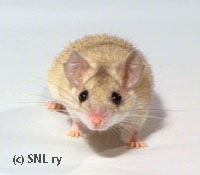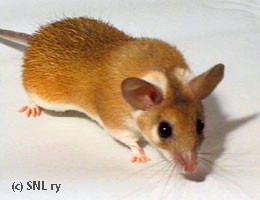Spiny Mice
Spiny Mouse Care Basics
In Finland (which is where this text was written) there are two species of spiny mice kept as pets; Egyptian spiny mouse and Nile spiny mouse. Egyptian is the more commonly found rounder species of spinies, Nile is rarer, more slender and has a more active temperament. There are currently two colour varieties in Egyptian spiny mice; Agouti and the lighter Cream, with "White Spotted" as the only available markings. Nile spinies are Blue in colour.
The following text deals mainly with the Egyptian spiny mouse.
There isn't that much difference between males and females with spiny mice. The easiest method of telling the sexes is apart is the fact that females have nipples and males do not. You can see the nipples as "rows of dots" both sides of the belly, the ones nearest the sex organs can be seen best. You can sex even a few days old spiny mice by the nipples. Young spiny mice have their nipples showing better than adults have. Spiny mice pregnancy last for 36-42 days and there are usually 1-4 babies in a litter. The babies are born rather "ready", not pink, blind and hairless like with most rodents. Nevertheless, the weaning age is at 4 weeks at the earliest and the babies are ready to go to new homes not before 6 weeks.
Housing
Spiny mice are best housed in plastic terrarium or glass tank with a wire mesh lid. The terrarium and especially the lid has to be escape-proof and gnaw- resistant, as an escaped spiny mouse may be rather hard to catch. When you're about to buy a terrarium for your spiny mice, check that the tank is escape proof. 4-5 spiny mice can be housed in a 60 -litre terrarium, but for a single spiny mouse the terrarium shouldn't be much smaller.

Cream spiny mouse from Siimis mousery |
Terrarium shouldn't be placed in draughty place or in direct sunlight. Choose a place where you can most easily feed your spiny mice, change their beddings and, of course, play with them. Take care, that other pets you have, do not get to your spiny mice. You should clean up the tank approximately once a week, depending on how many mice you have and how large the tank is. For beddings, use high quality products other that pine or cedar. You can give your mice hay in addition to other beddings. Do not use hamster nesting cotton or long "eco-fibres", as your mice can get tangled by their throat or legs.
Equipments
Along with beddings, spiny mouse needs drinking bottle, food bowl, salt- and mineral stones and a nest box in their abode. Do not put anything plastic in the tank -- it gets chewed up very quickly. All kinds of cardboard boxes (coffee, tea, biscuit etc) make excellent and cheap nests. Spiny mice love to chew holes in them, too. Remember to check that you don't accidentally put anything plastic in the tank with the boxes! At summertime you can give your spinies willow branches or branches of nontoxic trees, gathered from areas without pollution. Especially in early summer your spiny mice will love them.
Spiny mice are very active, so you can give an adult spiny mouse a running wheel. The wheel has to be safety wheel of metal and large enough. Wheels of other designs are dangerous and plastic wheels get chewed up quickly.
Spiny mice love to live in a group. Two males or two females love living together as well as if the animals were of the opposite sexes. You can best house together two spiny mice, who are either both young (that is 6 week olds or slightly older) or where one of the mice is young and the other adult. Getting two adult spiny mice, previously unknown to each others, may be hard. However, it depends on their personalities. You should be careful when introducing spin mice; change the beddings and nesting boxes, wash all other toys and monitor the situation closely. You can also use a cage designed for introducing hamster couples together (cage with dividing wall). There may, however, occur fights -- even bloody ones in spite of all your careful actions. Adult females may have difficult time accepting any new spiny mice in their territory.
Do not keep a male and a female together, as there would be litters born one after another and this would be a huge stress on the female. Furthermore, it isn't easy to find new good homes to all the babies, in spite of small amount of babies in a litter. If you're interested in breeding spiny mice, do get all possible information from experienced breeders before the first mating. Do not get your information from pet shops or commercial ("wholesale") breeders - some pet shops are notoriously ignorant on almost all aspects of good pet keeping and commercial breeders are not much better than the pet shops.

Egyptian spiny mouse |
Feeding
Main diet for spiny mice is rat/mouse lab blocks. These blocks should never be the green ones made for rabbits or guinea pigs. If you decide to give your spiny mice seed mix, remove all sunflower seeds and nuts. By adding oats to the seed mix, 1 dl oats to 1 litre of seed mix you can get a mix that suits better the needs of your mice. Food that contains too much fat results in less fit spiny mice and it makes their fur greasy.
Along with dry food, you can give your mice different kinds of porridges, berries, fruits, vegetables and cat or dog kibble. You should also give something hard to chew on, like dried bread. Spiny mice love different grains, especially oats. They also like to eat oranges, but oranges should not be given them too often.
The main thing to bear in mind with feeding is to have enough food available. Spiny mice are very active animals and therefore eat a lot. Give your spiny mice water to drink, from a water bottle. Water should be changed daily, on hot weather even more often.
Handling
Spiny mice are not born hand-tame, they must be handled on a regular basis, especially at young age. However, spiny mice aren't aggressive by nature and with a little effort they make wonderfully tame and calm pets. A timid animal should be lifted from the tank my forming a "cup" with both hands, taking the mouse in there. When you have your spiny mouse in your hand, you can scratch or pet it gently, talking in a soft voice. When you have just recently got your spiny mouse and it is still timid and maybe even a bit nervous, do not try to scratch it at once. Let your new pet get to know your hands, getting it to trust you. When your mouse gets trusty, it will take scratching calmly. NEVER lift a spiny mouse by its tail, do not even hold the mouse from the tail -- even by the base of the tail. The tail is very fragile and gets easily broken.
Be careful when handling your spiny mice so that it won't jump down from your hands -- they may not understand you're holding them high from the ground. Falling down from a high place may be extremely dangerous to your spiny mouse.
Text by: Tiina Andersin, Lotta Ahlfors, Kaisa Kattilakoski, Sanna M?ki-Tuuri.
How to Sex Spiny Mice?
Quite many people have told me about surprise litters, when they have left one or more males with the females by mistake. All in all, many say that sexing spiny mice is difficult. Well, it wasn't that easy for myself at first.
When sexing grown up mice, rats or gerbils you usually check if the animal has testicles; if there aren't the animal is naturally a female and if there are, it is a male. With spiny mouse males the testicles are quite small, so that the male goes for his great joy in with the females. But is the owner that happy?
Sexing the above-mentioned rodents, you usually compare the distance between the anus and the sex organs, which is usually longer with males than with females. Of course, this works with spiny mice as well - as long as you know how long the distance should be with males and females of different ages. Mice, rats and gerbils get usually so many babies that you can tell the sexes apart by comparing the babies (unless a large litter is all of the same sex). Spiny mouse litters are so small (1-4 babies) that comparing doesn't often work.
Here's the problem, but where's the answer? Check if your spiny mouse has nipples or not. If it has, it is a female. If not, it is a male. You can see the nipples as "rows of dots" both sides of the belly, the ones nearest the sex organs can be seen best. You can sex even a few days old spiny mice by the nipples. Young spiny mice have their nipples showing better than adults have.
There is one thing you should always remember before starting to check the sex of your spiny mouse: remember that you NEVER lift a spiny mouse by the tail. You have to turn the mouse over or look under the belly using some other method. You can put the mouse on a show box lid and try and look under the belly through the lid - you can do this with adults, not with young ones who may fall down. The tail of a spiny mouse is really fragile and it does not stand lifting. I myself have one spiny mouse bought from a pet shop with a broken tail, broken due to wrong handling.
Text by: Tiina Andersin
